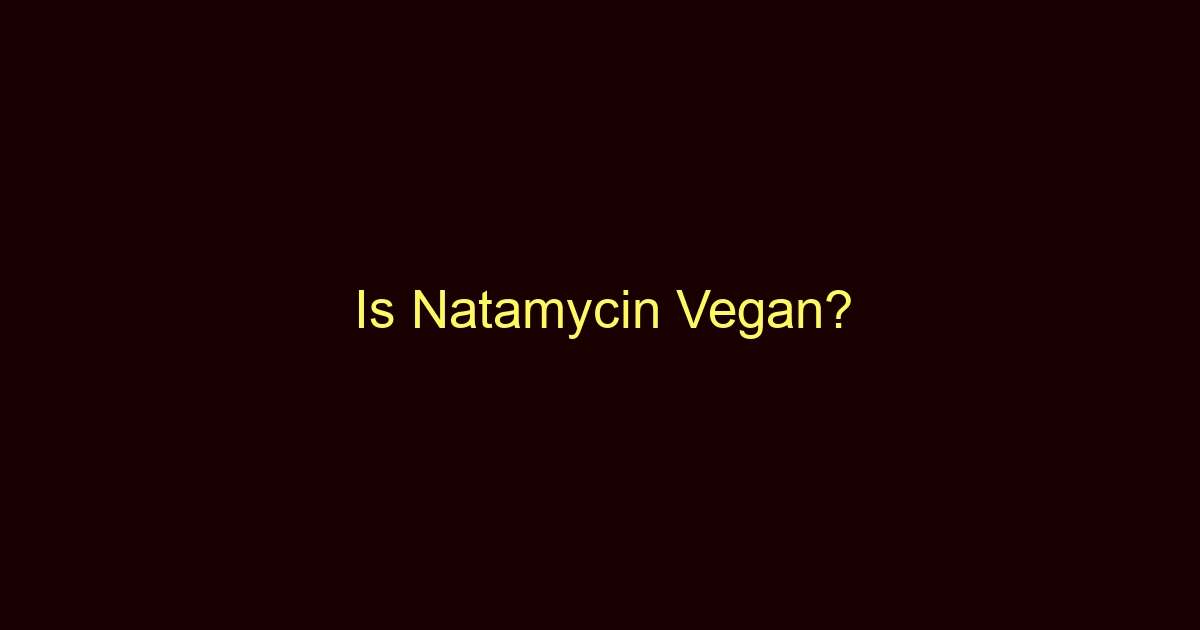Natamycin, a common food preservative, frequently appears in the ingredient lists of many of the foods we consume regularly. As such, it has been the subject of many questions, one of which includes its suitability for a vegan diet. In this article, we will explore natamycin in-depth to provide a clear and concise answer to this query.
What is Natamycin?
Natamycin, also known as pimaricin, is an antifungal agent produced by the bacterium Streptomyces natalensis. It’s frequently used in the food industry as a preservative to prevent the growth of mold and yeast in a variety of products, thanks to its efficient fungicidal properties. From dairy to meat products, and even in beverages, you’ll often find natamycin doing the behind-the-scenes work of keeping your food fresh for longer.
As it’s derived from bacterial fermentation, natamycin is considered a natural preservative. However, “natural” doesn’t always translate to “beneficial,” nor does it necessarily make it suitable for all dietary preferences and restrictions. So, what exactly is natamycin made of?
What is Natamycin Made of?
Natamycin is a polyene macrolide antibiotic. It’s derived from Streptomyces natalensis, a type of soil-dwelling bacteria. Through a process of fermentation, the bacteria produce natamycin, which is then harvested and used as a food preservative.
This antifungal agent essentially works by binding to ergosterol, a component of fungal cell membranes, inhibiting fungal growth and proliferation. This makes it a powerful tool in the food industry, protecting a multitude of products from mold and yeast contamination. Now, let’s delve into the common uses of natamycin and where you might typically find it.
What is Natamycin Used For?
Natamycin is primarily used in the food industry as a natural preservative. Its strong antifungal properties make it a popular choice for preventing mold and yeast growth in a range of food products.
You’ll often find natamycin in dairy products such as cheese, where it’s applied as a surface treatment. It’s also used in meat products, particularly processed meats, as well as in beverages like fruit juice and wine to prolong shelf life and maintain product quality.
What Foods Contain Natamycin?
The most common food to find natamycin in is cheese, as it’s regularly used as a surface treatment to prevent mold growth during aging. You may also find it in other dairy products like yogurt and sour cream. In addition to dairy, it’s used in processed meats and certain beverages, including fruit juice and wine, to prevent yeast and mold proliferation.
Is Natamycin Vegan?
Yes, natamycin is vegan. Despite its frequent use in dairy and meat products, the preservative itself is derived from bacteria, not animals. Therefore, it does not contain any animal products or byproducts, making it suitable for a vegan diet.
That said, while natamycin is vegan, it’s essential to remember that just because a food additive is vegan doesn’t mean all foods containing it align with a vegan diet. For example, while the natamycin used in cheese is vegan, the cheese itself, being a dairy product, is not.
Can Vegans Eat Natamycin and Why?
Vegans can consume natamycin as it’s a plant-based preservative produced by bacteria. It aligns with vegan criteria as it doesn’t involve the use of any animal-derived products or byproducts in its production.
However, just because natamycin is vegan does not mean that all products containing it are. Many of the foods that contain natamycin, like cheese and other dairy products, are not vegan. Therefore, it’s important for vegans to check other ingredients in the product to ensure they align with their dietary choices.
Safety and Controversy Surrounding Natamycin
While natamycin is generally recognized as safe by many food safety authorities worldwide, including the European Food Safety Authority (EFSA) and the U.S. Food and Drug Administration (FDA), it hasn’t been without controversy.
Some critics argue that there isn’t enough long-term research on the potential effects of natamycin consumption. While it’s been shown to be non-toxic in small amounts, concerns have been raised about potential effects on the human gut microbiota.
Additionally, while it’s used widely in some countries, other regions have restrictions on its use. For example, the United States allows natamycin in many dairy products, while the European Union permits it only as a surface preservative for certain cheeses and dried, cured sausages.
Natamycin in a Plant-Based Diet
Within a plant-based or vegan diet, you’re less likely to encounter natamycin as it’s often used in animal-derived products. However, it may still be present in vegan-friendly products like certain fruit juices and wines.
As it’s considered safe in small amounts, it doesn’t pose a problem for most people following a plant-based diet. But as always, it’s important to read labels and know what’s in your food. Just because something is plant-based doesn’t always mean it’s the healthiest choice, and whole foods should always be prioritized over processed ones.
Is Natamycin Safe?
Natamycin is safe for consumption in the small amounts typically found in food products. Major food safety authorities around the world, including the FDA and EFSA, recognize it as a safe food additive. However, people should still be mindful of potential allergies and personal tolerance levels to food additives in general. If any adverse reactions occur after consuming a product containing natamycin, it’s advisable to consult a healthcare professional.
Final Thoughts
Natamycin is indeed vegan-friendly as it is derived from bacteria and does not contain or require any animal products for its production. However, it’s crucial for vegans to always scrutinize the other ingredients in food products to ensure they align with their diet, as natamycin is often used in non-vegan products like cheese and processed meats.

